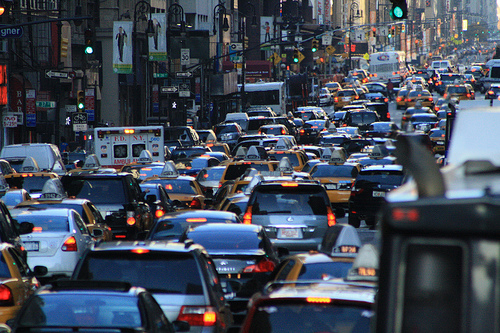Our car production lines are all silent, but there is a future for Australian manufacturing and it should include transportation.

Gridlock in New York. PHOTO Equipment World
Cars don’t mean a lot to me, and we all knew years ago that car production was ending in Australia. But when the final Holden rolled off the line last week it was impossible not to feel a sense of loss.
Less than a decade ago, four separate carmakers were employing tens of thousands of Australians to build cars. Now there are none.
Australia no longer makes cars because it couldn’t sell them. Foreign trade barriers and a chronically overpriced Australian dollar killed exports, while at home a rising abundance of imported brands, many backed by their own governments, steadily swamped the local offering.
The death blow was the Abbott government’s 2014 decision to terminate public subsidies. With the last vestige of government protection gone, market obstacles became insurmountable.
Manufacturing – making things – is an important marker of success for every country, every society. So should we have kept some sort of car-making industry going here? I think so, but certainly not in the form we got used to.
Petrol and diesel motor vehicles have dominated the lives of everyone born in the 20th century. Now we are having to face consequences. Hobart-based economist Rana Roy has been looking at these consequences, and has found a steadily mounting global crisis in the making.
A public policy economist, born in India and educated in Australia and the UK, Roy is a champion of civil society everywhere. He is a generalist in an increasingly specialised world, a builder of bridges between silos of learning and government and business.
In recent years, supported by the Organization for Economic Cooperation and Development and the World Health Organisation, he has been examining the causes and economic cost of air pollution, and with Norwegian Nils Axel Braathen has recently completed a report for the OECD.
Roy and Braathen have found strong evidence that road transport is now the leading cause of deaths related to air pollution in both Europe and the US, and heading in the same direction in emerging economies in Asia, Africa and South America.
In the 41 major economies included in the study, the annual toll of ambient air pollution – currently a rising trend – amounts to around 3.2 million deaths at a cost burden of over A$6.5 trillion. That’s around 6 per cent of the global economy.
Reducing road transport pollution from petrol and (especially) diesel is critical, says the report, which cites a rapid increase in the market share of diesel-powered vehicles as the main reason for sustained levels of air pollution in Europe.
Australia is better placed than more densely-populated places, but road transport is still a big contributor to urban air pollution. It is also Tasmania’s main source of greenhouse emissions.
Besides contributing to climate change, tailpipe emissions make urban dwellers everywhere less healthy than they should be, from spending too much time in and around fossil-fuelled vehicles. As long as such vehicles are occupying our streets we must find ways to limit their use.
Some cities, including Singapore, London and some other European cities, have tackled this problem head-on by making it more expensive to bring your diesel or petrol vehicle into the centre of the city. They call it congestion pricing.
Roy, once a member of the Board of Transport for London, is currently advising a New York team backed by New York governor Andrew Cuomo: politicians, engineers, planners and economists who are putting together a plan for a similar congestion prevention mechanism for their city
MoveNY is a response to rising and inequitable New York transit costs, poorly maintained roads, private vehicle congestion and outdated, inadequate public transport systems. It seeks to fix this with a sustainable, dedicated transportation revenue stream.
Referring to “years of neglect and maladministration” of the city’s subway system, the New York Times backs the plan, urging lawmakers to step up and get it through the state legislature.
All our cities, large and small, demand our attention to reduce congestion and lower air pollution. We need to improve traffic flows, invest in public transport and facilitate walking and cycling, but ultimately we need to find a way to eliminate fossil fuel altogether from road transport.
The logical alternative is transport powered completely by clean electricity. Tasmania is ideally placed to lead this transformation. Given greatly expanded wind and solar power generation, its predominantly hydro system would be an ideal fit with electric cars.
Which brings us back to Australia’s car industry. We’ve lost the assembly lines, but now we must quickly find ways of keeping our large network of remaining component manufacturers in business.
There are non-automotive options for this manufacturing sector, but with the world now turning to clean transport there has to be a big future in designing and manufacturing for a rapidly growing electric vehicle fleet – motors, regenerative brakes, batteries, charging stations and the like.
Three years ago Rana Roy said government should be reserving gas for domestic use and reining in excessive prices charged by monopoly power providers. He also warned that government neglect of manufacturing came at a cost, calling for heavy public investment in research and development.
Three years later, it’s way past time our leaders acted on that sage advice.
